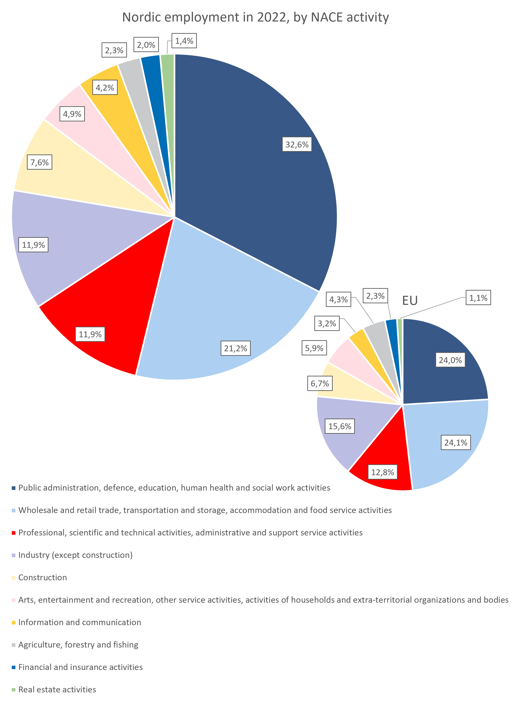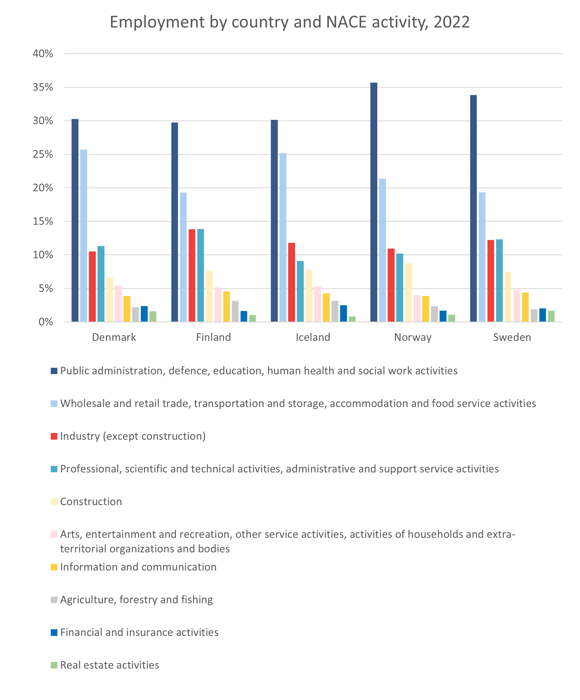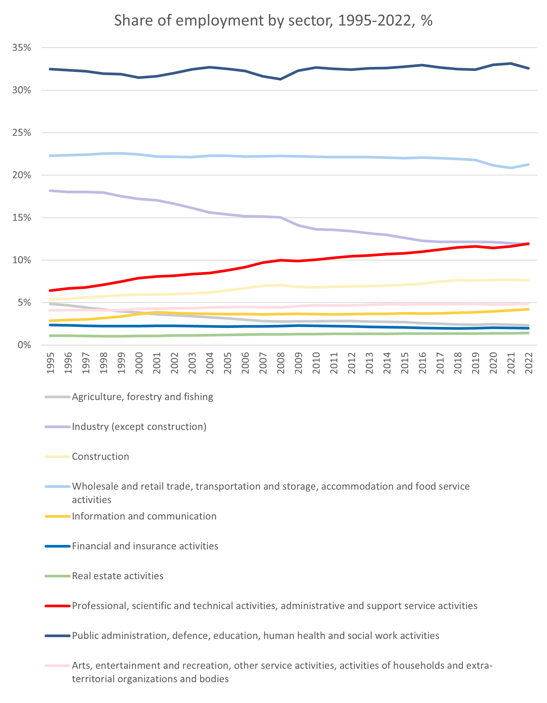Public sector employs one third of Nordic employees
In 2022, a third of all employees in the Nordic countries [1], including self-employed, worked in the “Public administration, defence, education, human health and social work activities” sector. This share has been constant since the start of the time series, in 1995. During the same period the “Professional, scientific and technical activities, administrative and support service activities” sector increased the most, from 6% to 12%, while the “Industry (except construction)” sector decreased the most, from 18% to 12%.
NACE is the acronym [2] used to designate the various statistical classifications of economic activities developed since 1970 in the European Union. NACE provides the framework for collecting and presenting a broad range of statistical data according to economic activity in the fields of economic statistics, for example production, national accounts or, like here, employment. [3]
Employment by sector in 2022
In 2022, a third of all employees in the Nordic countries worked in the “Public administration, defence, education, human health and social work activities” sector. The second largest sector, with just over one fifth of all employees, was “Wholesale and retail trade, transportation and storage, accommodation and food service activities”. The sectors “Professional, scientific and technical activities, administrative and support service activities” and “Industry (except construction)” share the third place with 12% of employees each.
The two largest sectors in the Nordics are also the two largest sectors in the EU, but in the EU they are equal in size - both cover just below 25% of employees each. This means that the public administration-sector is 8.6 percentage units smaller in the EU, but the wholesale and retail trade-sector is 2.9 percentage units larger. The “Industry (except construction)” sector is 3.7 percentage units larger in the EU and “Agriculture, forestry and fishing” is 2.0 percentage units larger. For all sectors the differences are minor, up to about one percent.
Please note that Faroe Islands and Greenland are excluded due to of lack of data and Åland is included in Finlands data.

Source: Nordic Statistics Database, NAAC08: Employment by activity by reporting country, unit, activity, type of employment and time
For the five Nordic countries having data for 2022, the distribution of employees over the NACE sectors is similar. The percentage in each sector varies slightly, but the order is the same except the two sectors – “Industry (except construction)” and “Professional, scientific and technical activities, administrative and support service activities” alternate in third and fourth place, respectively.

Source: Nordic Statistics Database, NAAC08: Employment by activity by reporting country, unit, activity, type of employment and time
Development over time
For a lot of the sectors, the share of employees have been stable.
The sector ”Public administration, defence, education, human health and social work activities” has been the largest during the entire reported period, coverering between 31 and 33% of employees. The”Wholesale and retail trade, transportation and storage, accommodation and food service activities” sector covered around 22% of employees, apart from the last few years when the pandemic visibly affected this sector.
The ”Industry (except construction)” sector has steadily decreased its share since 1995, from 18% to 12%, and the ”Agriculture, forestry and fishing” sector has decreased its share, from 5% to 2%.
The ”Professional, scientific and technical activities, administrative and support service activities” sector increased its share from 6% to 12% and the ”Construction” sector increased its share from 5% to 8%.

Source: Nordic Statistics Database, NAAC08: Employment by activity by reporting country, unit, activity, type of employment and time
_________________________________________________________________________________________________
[1] No data available for Faroe Islands or Greenland, but since these are smaller labour markets, this does not affect the shares significantly.
[2] NACE is derived from the French title “Nomenclature générale des Activités économiques dans les Communautés Européennes” (Statistical classification of economic activities in the European Communities).
[3] https://ec.europa.eu/eurostat/statistics-explained/index.php?title=NACE_background